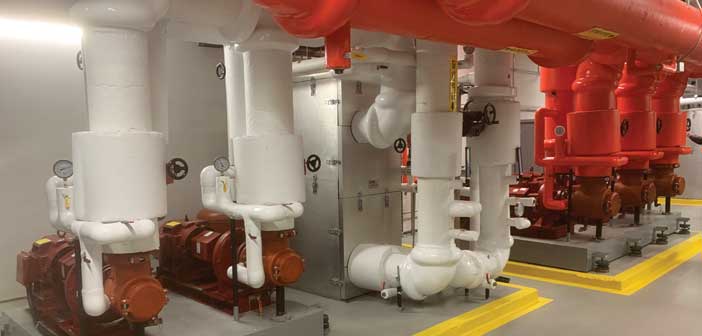For hotels, cooling and heating guestrooms and other areas of the property are costly endeavors. According to Energy Star, they represent almost 40% of the electricity and more than half of the natural gas used by lodging properties.
Some hotels, like the Shinola Hotel in Detroit and the Hilton Garden Inn Chicago McCormick Place, are turning to hydronic HVAC systems to cut costs and also help them reach their sustainability goals.
“A hydronic system is based around water, and water is one of the most efficient delivery systems of thermal energy,” said Alan Jones, senior director of product management, Xylem, a global water technology company. “Hydronic systems work like the bloodstream in your body. You have all these veins and arteries running everywhere, and they’re delivering oxygen to different parts of the body. Within a hydronic system, you have a series of pipes that are like capillaries and veins that run throughout the building and deliver thermal energy.”
He added that hydronic systems are “more efficient” than traditional HVAC because “you can utilize small circulators and valves with your thermostat to adjust exactly where the cool or hot air is going.”
Large campuses like universities or a group of office buildings have utilized hydronics by building a heat plant, where the water is heated in a central plant and then pumped to the buildings, according to Jones. Hotels can have their plant in a mechanical room.
“The plant is centralized for your heating and cooling and then all of the energy is distributed from there,” he said. “Water piping distributes that energy throughout the building and each unit will have a thermostat which can adjust the temperature and control the flow of that hot or cold water to an exchanger within the room to deliver the heat or cold.”
Moving from traditional HVACs that are placed in a room in a closet behind the wall to a hydronic system can also keep the property’s maintenance crew out of the guestroom.
“All of the building’s cooling and heating capacity is down in that mechanical room, where it can be monitored, maintained and optimized without someone having to go into the room,” said Jones.
With sustainability top of mind for both hoteliers and guests, Jones pointed out that hydronic systems can not only cut energy consumption, they also reduce a hotel’s carbon footprint because the HVAC systems will no longer be inside the guestrooms.
“A hydronic system is agnostic to what is generating the heat and cold that it is transporting,” he said. “There’s a big push in terms of trying to get to net zero emissions by 2050, and the International Energy Agency is putting a ban on fossil fuel boilers. There are a lot of technologies that are emerging to replace them, but if you have a hydronic system, you can connect any heat-generating or cold-generating system to the hydronics. So as you evolve and identify more efficient methods of generating heat or cold, you can plug them right into your system without having to do a complete building overhaul.”
Hydronic system installation can be done for both new-build and existing properties. Jones used the aforementioned Shinola Hotel, housed in what was the more than 100-year-old TB Rayl Company building, as an example of an adaptive-reuse property which retrofitted a hydronic system.
“The developers not only took a legacy building and gave it a facelift inside, but they also upgraded the heating and cooling system,” Jones said. “That gives the hotel great flexibility in the future. They’re not going to have to tear that building apart again when they want to change and upgrade the HVAC system.”
Buildings already equipped with hydronic systems can easily be upgraded with the newest technology for extra savings, while hotels installing them for the first time will also save costs over time.
“With the advent of improved hydraulics and motor-energy efficiency, which allows the system to adapt to demand, a hotel could be saving 30%-40% in energy just from that change,” Jones said. “That doesn’t take into account if you have an even-less-efficient forced air system that you’ve been relying on. From a sustainability standpoint, you’re not only looking at energy consumption but at the total mass of the units and the disposal cost replacement costs of all the hardware involved. When you go from 50 individual HVAC units down to that mechanical room that has a double suction or an end suction pump that’s got a 15-year useful life, you’re getting sustainability just from a reduction in the carbon footprint.”



